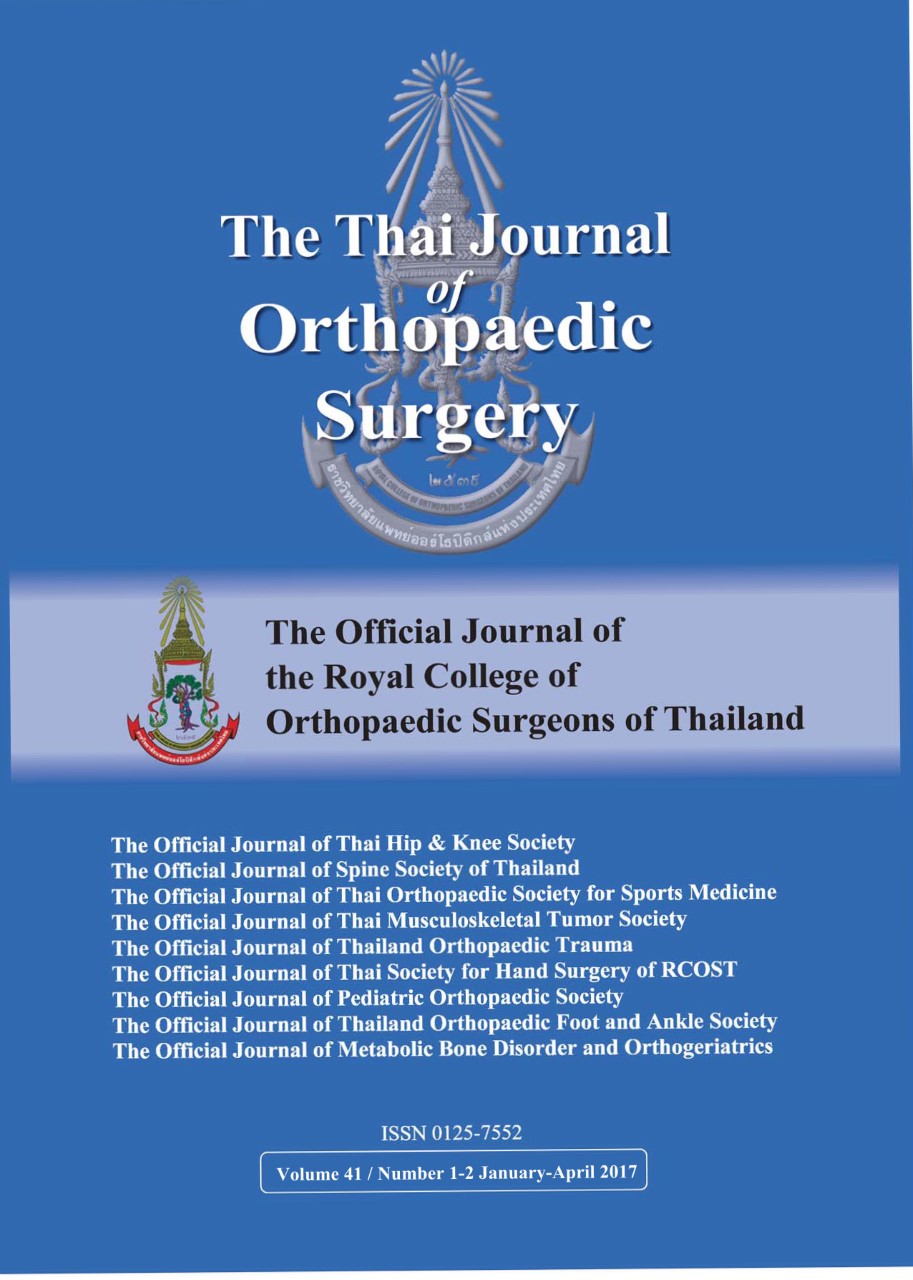Translation and Validation of the Thai Forgotten Joint Score for Knee Arthroplasty Patients
Main Article Content
Abstract
Introduction: Several patient-reported outcome measurements (PROMs) are used to evaluate the outcomes after knee arthroplasty. Joint awareness in everyday life, which is a new aspect to evaluate the outcome and the ability to forget the artificial joint, is claimed as the ultimate goal resulting in maximum patient satisfaction. The purpose of this study is to translate and validate a Thai version of the Forgotten Joint Score (TH-FJS).
Methods: We performed the Thai translation procedure based on an internationally accepted standard. Between November 2017 and June 2018, we evaluated the TH-FJS for validity and reliability. In the validity study, the patient following knee arthroplasty completed the TH-FJS questionnaire, Oxford Knee Score (OKS), and Western Ontario & McMaster Universities Osteoarthritis Index (WOMAC). The test-retest evaluation was performed in the reliability study with a 2-week interval. A ceiling effect was defined as participants reaching a score within 15% of the maximum score.
Results: There were 85 patients (average age, 71.0 years) included in this study. The test-retest reliability of the TH-FJS was high with an intraclass correlation coefficient (ICC) = 0.95 (95% CI 0.9, 0.97). We found a high level of internal consistency with a Cronbach’s α of 0.92. The ceiling effect for the TH-FJS was 28%, as compared to 49% for OKS, and 58% for WOMAC.
Conclusion: The Thai language version of the FJS had high level of internal consistency and was proved to be a reliable tool for evaluating knee arthroplasty patients in Thailand. The low ceiling effect characteristic of the score can help the surgeon to detect small difference in the good and excellent outcomes after knee arthroplasty.
Article Details
References
2. Gunaratne R, Pratt DN, Banda J, Fick DP, Khan RJ, Robertson BW. Patient dissatisfaction following total knee arthroplasty: a systematic review of the literature. J Arthroplasty. 2017; 32(12): 3854-60.
3. Harris IA, Harris AM, Naylor JM, Adie S, Mittal R, Dao AT. Discordance between patient and surgeon satisfaction after total joint arthroplasty. J Arthroplasty. 2013; 28(5): 722-7.
4. Stewart AL, Hays RD, Ware JE Jr. The MOS short-form general health survey: reliability and validity in a patient population. Med Care. 1988; 26(7): 724-35
5. Bellamy N, Buchanan WW, Goldsmith CH, Campbell J, Stitt LW. Validation study of WOMAC: a health status instrument for measuring clinically important patient relevant outcomes to antirheumatic drug therapy in patients with osteoarthritis of the hip or knee. J Rheumatol. 1988; 15(12): 1833-40.
6. Roos EM, Roos HP, Lohmander LS, Ekdahl C, Beynnon BD. Knee Injury and Osteoarthritis Outcome Score (KOOS)--development of a self-administered outcome measure. J Orthop Sports Phys Ther. 1998; 28(2): 88-96.
7. Dawson J, Fitzpatrick R, Murray D, Carr A. Questionnaire on the perceptions of patients about total knee replacement. J Bone Joint Surg Br. 1998; 80(1): 63-9.
8. Behrend H, Giesinger K, Giesinger JM, Kuster MS. The “forgotten joint” as the ultimate goal in joint arthroplasty: validation of a new patient-reported outcome measure. J Arthroplasty. 2012; 27(3): 430-6.
9. Jia C, Ni M, Fu J, Li X, Li X, Chai W, et al. A comparative study on effectiveness of patellar resurfacing against non-resurfacing in total knee arthroplasty[Abstract]. Zhongguo Xiu Fu Chong Jian Wai Ke Za Zhi. 2018; 32(4): 394-9.
10. Bonnin MP, Rollier J-C, Chatelet J-C, Ait-Si-Selmi T, Chouteau J, Jacquot L, et al. Can patients practice strenuous sports after uncemented ceramic-on-ceramic total hip arthroplasty?. Orthop J Sports Med. 2018; 6(4): 2325967118763920.
11. Kamenaga T, Muratsu H, Kanda Y, Miya H, Kuroda R, Matsumoto T. The influence of postoperative knee stability on patient satisfaction in cruciate-retaining total knee arthroplasty. J Arthroplasty. 2018; 33(8): 2475-9.
12. Olach M, Gerhard P, Giesinger K, Lampert C, Erhardt JB. Clinical and radiological outcome at mean follow-up of 11 years after hip arthroscopy. Arch Orthop Trauma Surg. 2018: 1-6.
13. Behrend H, Giesinger K, Zdravkovic V, Giesinger JM. Validating the forgotten joint score-12 in patients after ACL reconstruction. Knee. 2017; 24(4): 768-74.
14. Hamilton D, Giesinger J, MacDonald D, Simpson A, Howie C, Giesinger K. Responsiveness and ceiling effects of the Forgotten Joint Score-12 following total hip arthroplasty. Bone Joint Res. 2016; 5(3): 87-91.
15. Matsumoto M, Baba T, Homma Y, Kobayashi H, Ochi H, Yuasa T, et al. Validation study of the Forgotten Joint Score-12 as a universal patient-reported outcome measure. Eur J Orthop Surg Traumatol. 2015; 25(7): 1141-5.
16. Baumann F, Ernstberger T, Loibl M, Zeman F, Nerlich M, Tibesku C. Validation of the German Forgotten Joint Score (G-FJS) according to the COSMIN checklist: does a reduction in joint awareness indicate clinical improvement after arthroplasty of the knee?. Arch Orthop Trauma Surg. 2016; 136(2): 257-64.
17. Thomsen MG, Latifi R, Kallemose T, Barfod KW, Husted H, Troelsen A. Good validity and reliability of the forgotten joint score in evaluating the outcome of total knee arthroplasty: A retrospective cross-sectional survey-based study. Acta Orthop. 2016; 87(3): 280-5.
18. Cao S, Liu N, Han W, Zi Y, Peng F, Li L, et al. Simplified Chinese version of the Forgotten Joint Score (FJS) for patients who underwent joint arthroplasty: cross-cultural adaptation and validation. J Orthop Surg Res. 2017; 12(1): 6.
19. Bullinger M, Alonso J, Apolone G, Leplège A, Sullivan M, Wood-Dauphinee S, et al. Translating health status questionnaires and evaluating their quality: the IQOLA project approach. J. J Clin Epidemiol. 1998; 51(11): 913-23.
20. Landis JR, Koch GG. The measurement of observer agreement for categorical data. Biometrics. 1977; 33(1): 159-74.
21. Cronbach LJ. Coefficient alpha and the internal structure of tests. Psychometrika. 1951; 16(3): 297-334.


